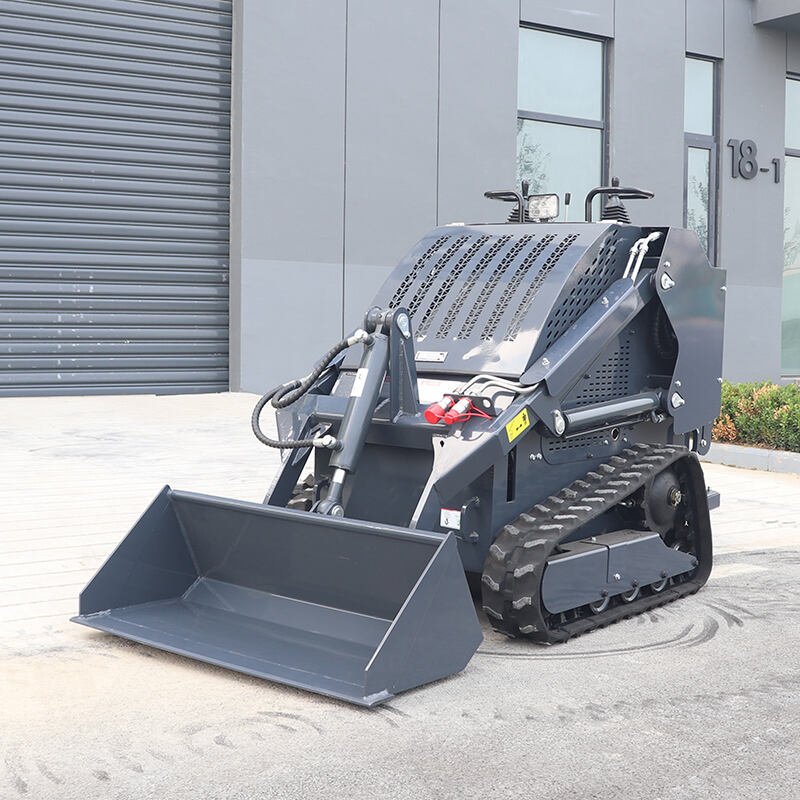Kirish
Bu, tayyorlangan va paydo bo‘lgan narsalar orasida eng kam baholangan ishlab chiqarilgan narsalardan biri hisoblanishi mumkin, shuning uchun ularga kuchli va ko‘p funksiyali xususiyatlari mavjud. Ularning osonroq, qulay va ko‘pfunksional ekanligi sababli, zamonaviy versiyalari juda chiroyli. Shu bilan birga, ularga yaratilgan dizayn tizimlari orqali, ular yurak ro‘yxatidagi har qanday vazifani bajarish uchun mo‘ljallangan: tozalash, yukni tekislashtirish, qozonni olib tashlash va qor oldidan himoyalash kabi. Bu yerda skid steerdan (o‘tirganda suruvchi mashinasi) foydalanishning maqsadlarini, turli xavfli holatlarni oldini olish uchun qanday ishlatish kerakligini, hamda qaysi sanoat sohalarda ishlatilishi kerakligini o‘rganamiz.
Tarixi va rivojlanishi
Ikkinchi Dunyo urushi jangida bepul yuraklarini tozalash uchun zarurat sababidan foydalanilgan skid steer loaderlar, eng kichik oqim bilan bir vaqtda juda ko'p funksiyalar bilan mashina taklif etgan. Teknologik rivojlanish orqali skid steer loaderlar dekaden ichida quvvat, stabillik va qo'llanma qadamlariga yangi imkoniyatlarni berdi. Ushbu kompakt tizim klassi avtomatlashtirish va davriddoshlik bo'yicha faqat boshlang'an holda rivojlaniyapti, chunki ko'rsatilgan yangi mashinalarning ko'pgina nesri keyingi muammolar turini ifodalaydi.
Turlari va modellari
Skid steer loader asosan ikki turdagi: ro'l paydoz skid steer va kompakt yol yo'liy mashinalar (CTLs). Rulik skid steer mashinalari qatorli va teng sathlar uchun ishga o'rnatilgan, ular tez harakatlanuvchi va shunchaki burilishlarga imkon beradi, bu esa ulardni qurilish obyektlari ichida va tashqarida eng mashhur muhim texnikalaridan biri qiladi. Kompakt yol yo'liy mashinalar esa naram yoki tengsiz zamonshak sathlarida ko'proq traksion, stabillik va suv ostida ishlash imkoniyatini ta'minlaydi, bu esa paydoz va kengroq vazifalarda ishlatish uchun yaxshi variant hisoblanadi.
Imkoniyatlari va qo'llanmalar
Skid steer loaderlar ajoyib qadrlarli mashinalar; ularning qo'llanma tizimi ularni qulaylik bilan hamma turdagi mashinaga aylantiradi. Tashqoracha va yer ko'zlashlari esa eng keng tarqalgan vazifalardir, bu erda turli turdagi yer uchun bortlar va augerlar ishlatiladi. Palet forklari va grappellar materiallarni ushlab olishni oddiy qiladi, tomonidan esa chiziq va rakkalar paydo bo'lgan paysaj va darajali vazifalar uchun asbob sifatida xizmat qiladi. Shuningdek, mashinani oldindan berilgan ishlarga moslashtirish uchun 100 dan ortiq standart qo'llanma bor, bu esa ushbu ajoyib foydaliyatga qo'shimcha bo'ladi.
Quvvat va bajaruv
Skid steer loader juda kichik joyga juda ko'p quvvat sig'diradi. Ular o'z o'lchamidagi mashinalardan tashqarida deb o'ylagan yuklar va ishlarni bajarishi mumkin, quvvat-o'lcham nisbati esa katta mashinalar bilan raqobatlashishi mumkin. Ot kuchi va aylanish momenti reytinglari modelga qarab farq qiladi, lekin har biri zarur bo'lganda kerakli kuchni taqdim etish uchun mo'ljallangan. Qattiq tutqich, ayniqsa, ixcham izli yuk ko'taruvchilar, Qo'llab-quvvatlash og'ir yuklarni ko'tarishi va tortish kuchini buzmasdan ko'proq og'irlikni surishi kerak. Ular buni past yer bosimi bilan katta yer yuzasi bo'ylab ko'proq teng taqsimlangan yuk taqsimoti orqali amalga oshiradilar.
Xavfsizlik xususiyatlari va amallari
Xavfsizlik narsalariga doir bo'lganda, slip steer yuk tashuvchilarini ishga tushirishda oshin qat'in bo'lmaslik kerak. Operatorlarni to'g'ri ta'lim bergan va sertifikatlangan bo'lishi shaxsning ushbu mashina qanday ishlaydiganini va cheklovlari haqida bilishi zarur. Roll-over himoyalari (ROPS) va tepadan yuqoridan tushgan obyektlardan himoyalari (FOPS), bu hech qachon boshqarilmaydigan turdagi xavfsizlik mekanizmlari hisoblanadi. Mashinani va uni bilan ulangan qismlarni ishga tushirishdan oldin muammolar mavjud emasligini tekshirish uchun kunduzgi tekshiruvlar talab etiladi. Operatorlarga darhal jarayonlarga javob berish uchun qadam-qadam talablarga amal qilish, masalan, emergency to'xtatish qanday ishlaydi.
Ta'mirlash va parvarishlash
Har qanday ish ovozi kabi, slip steer yuklovchilarga ham to'g'ri xizmat ko'rsatish kerak. Fabrika tomonidan taklif etilgan regulyar asosida xizmat vaqtlari mavjud. Motor va hidravlika tizimlari uchun xizmatda suvlangan yoki suv sathi bo'yicha talablar mavjud bo'ladi. Kompakt trek yuklovchilarining pastki qismi va trekalarida performansiga ta'sir qilishi mumkin bo'lgan axlat yetkazishi bor. Sezonda emasligi davom etgan paytda ular elementlardan himoyalangan bo'lishi kerak va ularga berilgan joy belgilari bilan bir necha darajada yomonlikdan himoyalash imkoniyati ham bo'lishi kerak.
Narx va effektivlik
Soddalashtirilgan va narxiga nisbatan past xarajatlarga ega bo'lgan ishlab chiqarish orqali o'zining analoglari bilan solishtirilganda, skid steer loader hech narsa uni qo'llab-quvvatlay olmaydi. Boshlang'ich investitsiya model va qo'shimcha qurilmalar asosida o'zgarishi mumkin, lekin ishlash xarajati kattaroq texnika dan past. Shuningdek, ba'zi model turkumlari boshqalaridan ko'ra ekonomikroq bo'lishi mumkinligini hisobga oling. Ular juda qimmat bo'lishi mumkin, ammo tipik ROI (investitsiyaga qaytish) boshqa mashinalarga muvofiqlik qiladigan 2 yoki undan ko'p vazifani bajaring;
Muhitga ta'siri
Bu skid steerdagi yerga qaramasdan, u holda ekologik jihatdan juda qulaydir. Ish joyidan oldindan olinadigan mashinalar soni kamroq, shuning uchun benzin va ekspresion kamroq, demak, bu yuklovchi bir nechta foyda taklif qiladi. Va yerga qaramasdan mashina yumshaq yoki himoyalangan yerda tez-tez ishlay oladi. Yer singiroqligi va ayollaridan himoyalash; qurilish va paysajdagi minimal ekologik ta'sir
Istalgan holat va misollar
Turli xil ish yulduzalarining qisqacha ma'lumotlarini o'qishingiz mumkin, bu esa skid steer yuklovchilarining qanday ko'p turdagi ishlarda ishlatilishi mumkinligini aks ettiradi. Ushbu mashinalar, shunchaki tikroq joyda harakatlanishidan xabar qiluvchi qurilish maydonlaridan paydo bo'lgan, grading imkoniyatlari jahanda landscapinq operatsiyalari orqali isbot etgan. O'tilgan me'yorlarga muvaffaqiyat bilan javob berish uchun, maxsus kengaytmalar yaratildi, bu esa traksiya va stabillik talablariga javob beradi.
Xulosa
Skid steer yuklovchi, qurilish va payvoqchilikda kichik texnika quvvatini ifodalovchi kompakt mashinalardan biridir. Ularning keng tarqalgan vazifalarni bajarish imkoniyati, kichik hajmi va qurolligi ularni o'zaro vazifalarni bajarish va ko'plab vazifalarni bajarish talablari bo'yicha muhim vositalarga aylantiradi. Ammo, ularning qanday natijalarga ega bo'lishiga qaraganda, xavfsiz ishlatish va xizmatlashtirishni amalga oshirish orqali ular loyihalarining umumiy effektivligini oshirishda katta rol oynaydi.

 ONLAYN
ONLAYN